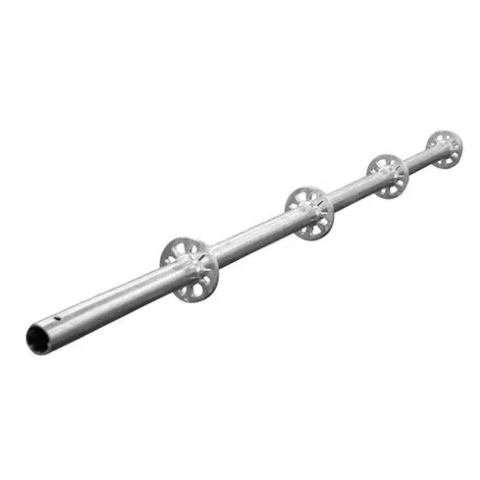English 

T: +86-18842539857
E: anniescaffolding@163.com
E: anniescaffolding@163.com
Room No.203, Building No.5, Huijin Plaza, West Fifth Road No.35, Tianjin Airport Economic Zone, Tianjin, China

Views: 0 Author: Site Editor Publish Time: 2025-09-24 Origin: Site









Every construction site has unique requirements, and selecting the right scaffolding system often determines how safe, efficient, and cost-effective a project will be. Ringlock Scaffolding has become a leading choice worldwide because of its flexibility, strength, and fast installation. At Tianjin Easy Scaffolding, we help contractors and project managers identify the best configuration to match their site conditions. This guide walks you through practical checklists, system comparisons, and buyer notes so you can confidently choose the most suitable scaffolding for your next project.
Choosing a scaffolding system is not simply about price—it depends on the size of your build, the geometry of the structure, and the speed of installation you need. Ringlock Scaffolding is designed to adapt across a wide spectrum of project demands. Here are the main factors to consider.
For small-scale renovation or maintenance work, Ringlock can be set up in compact modules without wasting space. On medium-sized projects such as residential developments, the system balances cost and flexibility, ensuring both workers and materials can move safely. For large-scale industrial or commercial sites, Ringlock’s modular rosette design makes it possible to build high-load towers and extended facades while maintaining stability. The same system can scale up or down without changing the core components, saving procurement time. Another advantage is that contractors can reuse the same inventory across multiple projects of different scales, which reduces overall ownership costs.
Not all buildings are simple cubes. When working with curved facades, irregular shapes, or industrial installations, Ringlock Scaffolding shines. The rosette connection allows ledgers and braces to connect at multiple angles, forming stable frameworks even on challenging geometry. Straight wall facades can use standard bay layouts for cost efficiency, while bridges, chimneys, or refineries can benefit from custom angled set-ups. For restoration or historic buildings where protecting the original structure is critical, the adaptability of Ringlock also reduces the need for invasive anchor points.
Project schedules are tight, and delays often mean higher costs. Ringlock’s key advantage is speed: components slot into the rosette and lock with wedges, reducing assembly time compared to traditional tube-and-coupler methods. For projects that require routine but not urgent installations, other systems may suffice, but if time is a priority, Ringlock ensures faster returns on labor hours. In addition, because fewer tools are required during assembly, the system minimizes both labor fatigue and risk of error, contributing to safer and more productive sites.
Ringlock Scaffolding is not one-size-fits-all; it can be configured in different ways depending on the project’s load, safety, and access needs.
Standard bay layouts are the foundation of Ringlock use. They consist of vertical standards and horizontal ledgers, creating bays that can be easily repeated across a facade. Common bay sizes allow uniform spacing for planks, giving workers consistent walking surfaces. These set-ups are typically used on residential buildings, commercial walls, or maintenance works where uniformity is efficient. Contractors can quickly expand or contract these bays as needed, ensuring the same scaffolding serves multiple phases of a project.
When projects require higher load capacity—such as supporting formwork for bridges or large slabs—Ringlock can be assembled into heavy-duty towers. Multiple ledgers and diagonal braces reinforce the structure, turning the modular system into a powerful shoring solution. Contractors often choose this option when working with concrete or heavy equipment. Another benefit is that heavy-duty Ringlock towers can be combined with standard scaffolding layouts, creating hybrid systems that maximize both strength and workspace efficiency.
Beyond the core components, accessories enhance functionality. Transoms add extra plank support for broader platforms. Truss ledgers span wider openings without reducing strength, ideal for stages or industrial access. Stair towers ensure safe and fast vertical movement for crews, reducing downtime and increasing site productivity. These accessories make the system versatile enough for everything from public events to high-rise construction. In practice, accessories also extend the service life of the system, since site managers can adapt existing scaffolding rather than purchasing entirely new equipment.

Scaffolding systems vary in connection design, strength, and adaptability. Buyers often compare Ringlock with Cuplock and Kwikstage to decide which system matches their site.
Ringlock Scaffolding: Known for its rosette design, it allows multiple ledgers to connect at different angles, making it versatile for complex projects. It offers high load capacity and fast installation. Its modular nature adapts to almost any scale.
Cuplock Scaffolding: Recognized for its cup-joint connections, Cuplock works well for straight-line facades and vertical access. It is durable and widely used in industrial plants but less flexible when dealing with irregular shapes.
Kwikstage Scaffolding: Popular in regions like Australia and the UK, Kwikstage is quick to erect and user-friendly, especially for residential and smaller projects. However, it may not provide the same heavy-duty capacity as Ringlock.
Contractors often prefer Ringlock when facing diverse project types, Cuplock for heavy-duty repetitive industrial work, and Kwikstage for straightforward small-to-medium builds. Understanding these differences helps ensure the investment matches the intended use. For multinational contractors, stocking Ringlock often proves more cost-effective because the same system can adapt across markets and applications.
Scaffolding is only as reliable as the materials and quality standards it meets. Buyers should always confirm product details with suppliers before procurement.
Steel grade: Q235 and Q345 steel are commonly used, with Q345 offering higher strength for heavy-duty applications.
Coating: Hot-dip galvanizing with a minimum of 60µm coating provides rust resistance and extends service life, especially for projects in coastal or humid climates.
Weld quality: Smooth, tested welds reduce the risk of failure under load. Buyers should request inspection reports or visit supplier factories when possible.
International projects often require compliance with recognized scaffolding standards. The most common include:
EN12810 / EN12811 (Europe)
AS/NZS1576 (Australia/New Zealand)
ANSI/ASSE A10.8 (United States)
Suppliers like Tianjin Easy Scaffolding provide certification to meet these standards, giving assurance of safety and regulatory compliance. When selecting a supplier, requesting test reports and third-party inspection certificates is always advisable.
Even with the right system, procurement mistakes can lead to delays or unexpected costs. A reliable supplier makes a critical difference.
Lead time: Confirm production schedules and shipping windows to avoid holding up construction.
Export experience: International projects require suppliers familiar with customs, documentation, and packing standards.
Packing for sea containers: Proper bundling and labeling protect materials during long transport.
Spare parts: Ensure suppliers can provide replacement components quickly to avoid downtime.
Quality assurance: Look for suppliers with systematic QA testing, ensuring consistency across every batch.
Tianjin Easy Scaffolding has supplied over 1,500 containers annually to global markets, with proven export experience to North America, South America, Australia, New Zealand, Southeast Asia, and the Middle East. This track record provides buyers with confidence that orders will be fulfilled smoothly, no matter the project’s destination.
Selecting the right Ringlock Scaffolding configuration depends on your project’s size, geometry, and timeline, as well as the standards and supplier support behind it. With its modular rosette design, high durability, and international certifications, the system offers one of the most adaptable solutions in the industry. At Tianjin Easy Scaffolding, we provide tailored layouts and specifications to match your requirements and ensure a safe, efficient build. For more details or to request a project-specific proposal, contact us today.